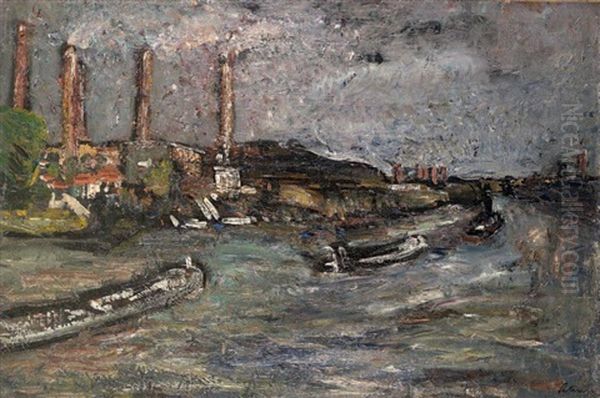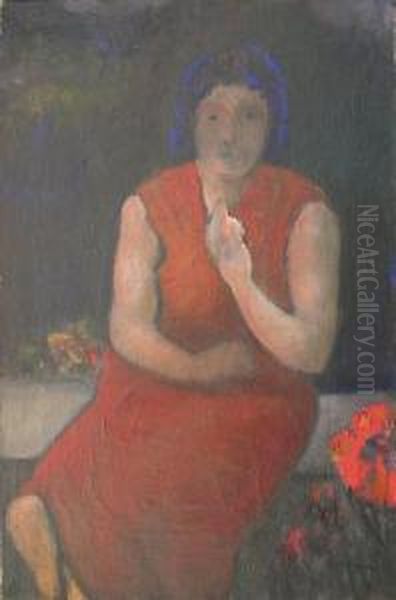Adolphe Péterelle, a French painter active during a vibrant period of European art history, remains a figure whose work is appreciated primarily through his surviving canvases rather than extensive historical documentation. Born in 1874 and passing away in 1947, his career spanned decades marked by significant artistic evolution, though details about his personal life and specific affiliations remain scarce according to available records. He worked primarily in oil paint, focusing largely on landscapes, but also demonstrated skill in figure painting and etching.
Péterelle's identity as a painter is confirmed, and his French nationality is evident through his subjects and context. While one source suggests an active period between 1932 and 1941, the broader lifespan of 1874-1947 aligns more consistently with the dates attributed to several of his known works, suggesting the former period might represent a specific phase of activity or documentation rather than his entire career.
Biographical Sketch (Acknowledging Limitations)
The fundamental biographical data points for Adolphe Péterelle are his lifespan, 1874 to 1947, and his profession as a painter of French origin. Beyond these facts, the available source materials consulted offer frustratingly little detail. Specific information regarding his exact date and place of birth, his upbringing, artistic training, personal life, or even the circumstances of his death are not readily found in the referenced documents.
Similarly, the sources explicitly state that no specific anecdotes or notable incidents from his life have been recorded or uncovered in the research conducted. This lack of personal narrative makes it challenging to construct a traditional biography. His story, therefore, must be pieced together primarily through the analysis of his artistic output and his presence within the art market of his time. The discrepancy regarding his active years (1932-1941 vs. 1874-1947) highlights the fragmented nature of the information currently available.
Artistic Style and Focus

Adolphe Péterelle's artistic identity is most strongly associated with landscape painting. His works demonstrate a clear affinity for depicting natural scenes, often imbued with a sense of tranquility and careful observation. He predominantly used oil paint, applying it with techniques that suggest attention to detail, brushwork, and the nuanced effects of light and color. His style often leans towards naturalism, aiming to capture the visual reality of the scenes he portrayed.
His paintings frequently showcase a sensitive handling of light and shadow, contributing to the overall mood and atmosphere. There is an emphasis on achieving a harmonious balance of colors, reflecting a deep appreciation and understanding of the natural world. While landscapes form the core of his known oeuvre, Péterelle also incorporated figures into his compositions, suggesting a versatility that extended beyond pure scenic representation. This integration of human elements often adds a narrative or contextual layer to his depictions of nature.
The overall impression conveyed by his style is one of competence and a dedication to capturing the beauty and subtleties of the environment, whether it be a rustic landscape, a lakeside scene, or a more formally structured garden. His approach suggests a connection to traditional representational painting, refined by a personal sensitivity to his subjects.
Representative Works
Several specific works provide insight into Adolphe Péterelle's artistic practice and thematic interests. Among his notable oil paintings is Paysage, dated 1909. This landscape piece, measuring 72.5 x 53.5 cm and signed in the lower right, exemplifies his focus on natural scenery. It appeared on the art market, indicating its circulation among collectors. Another work, Paysage au bateau, features a landscape incorporating a boat, further highlighting his interest in scenes combining nature and elements of human activity, though its specific date is not provided in the sources.
Péterelle also engaged with figure painting, as seen in Femme en robe rouge (Woman in Red Dress), dated 1908. This work demonstrates his ability to render the human form and attire, suggesting skills beyond landscape painting. Another significant piece is BAIGNEUSES AU BORD DU LAC (Bathers by the Lake), an oil on canvas measuring 38 x 46 cm and dated 1924. This work combines figure study with a landscape setting, depicting bathers in a natural environment, showcasing his handling of both anatomy and the interplay of light on water and land.

Beyond oil painting, Péterelle also worked in etching. A notable example is his etching titled Versailles Gardens. This piece depicts the famous gardens of the Palace of Versailles, capturing the characteristic features of French Baroque garden design – orderly lawns, structured arrangements of trees, distant hills, and figures populating the space, creating a lively yet harmonious atmosphere. This work points to an interest in architectural and designed landscapes as well.
Influences and Artistic Context
While the available sources do not definitively link Adolphe Péterelle to specific mentors or formal artistic movements, his work can be situated within the broader context of French art during his lifetime. His focus on landscape, light, and color, particularly in works from the early 20th century, suggests a potential awareness of, if not direct influence from, Impressionism and Post-Impressionism, which had revolutionized French painting in the preceding decades. Artists like Claude Monet and Camille Pissarro had set precedents for landscape painting that resonated throughout this period.
A specific influence noted in the sources relates to his etching Versailles Gardens. This work clearly shows an engagement with the aesthetics of French Baroque garden design, indicating an appreciation for this historical style and its visual principles of order, grandeur, and harmony between nature and human design. This suggests Péterelle drew inspiration from diverse sources, including historical art and landscape architecture.
Furthermore, Péterelle is mentioned as being among the painters associated with the "École de Paris" (School of Paris). This term does not refer to a single institution or cohesive movement but rather describes the diverse community of French and foreign-born artists who converged in Paris during the first half of the 20th century. Working within this milieu would have exposed him to a wide range of styles and ideas, from Fauvism (e.g., Henri Matisse, André Derain) to Cubism and various forms of figurative and abstract art. His own naturalistic style, however, seems distinct from the more avant-garde tendencies often associated with the School of Paris. The sources confirm no affiliation with any specific, formally organized art group or society.
Péterelle and His Contemporaries
The provided documentation offers no specific information regarding Adolphe Péterelle's personal or professional relationships – collaborations, rivalries, or friendships – with other artists of his time. His active years, however, placed him squarely within one of the most dynamic periods in art history, centered largely in Paris. He worked contemporaneously with a vast array of influential figures who shaped modern art.

While direct interactions remain undocumented, it is certain that Péterelle shared the artistic landscape with giants of Impressionism and Post-Impressionism whose influence still lingered, such as Claude Monet, Pierre-Auguste Renoir, and Camille Pissarro, as well as the foundational modern master Paul Cézanne.
During the peak years of his potential activity, Paris was the hub for Fauvism, led by artists like Henri Matisse, André Derain, and Maurice de Vlaminck. The city also nurtured the diverse talents grouped under the École de Paris umbrella, including figures like Amedeo Modigliani, Chaim Soutine, Marc Chagall, and Kees van Dongen. Landscape painting continued to evolve through artists like Albert Marquet, while others like Raoul Dufy developed distinctive decorative styles.
The sources do mention that Péterelle's work appeared in auction catalogues alongside artists such as Constantin Andreevitch Tcherevkin and Nejedly. While perhaps less universally famous than the aforementioned modern masters, their inclusion alongside Péterelle in market contexts provides a glimpse into the specific segment of the art world where his works circulated. His contemporaries, therefore, ranged from the vanguards of modernism to competent practitioners working in more traditional or established styles.
Market Presence and Historical Assessment
Adolphe Péterelle's artistic achievement, as reflected in the available sources, is primarily measured through the presence and valuation of his works in the art market. Specific auction results provide concrete evidence of his recognition among collectors. For instance, his 1909 Paysage was estimated at €800 to €1,000 in a 2008 sale. Similarly, his 1924 painting BAIGNEUSES AU BORD DU LAC achieved an estimate of €1,000 to €1,200 at auction. These figures indicate a consistent, albeit modest, market value for his oil paintings during the early 21st century.
The appearance of his works in auction catalogues, sometimes listed alongside contemporaries like Constantin Andreevitch Tcherevkin and Nejedly, confirms his status as a known entity within certain art market circles. He was recognized enough for his works to be catalogued, attributed, and traded.
However, the sources consulted do not provide evidence of a broader historical impact or significant critical acclaim from art historians during or after his lifetime. There is no mention of major solo exhibitions, influential critical reviews, or a lasting legacy that significantly altered the course of French art. His historical assessment, based purely on the provided information, positions him as a skilled French painter, particularly of landscapes, whose works possess aesthetic merit and market value, but who did not achieve the widespread fame or transformative influence of the leading artists of his era.
Conclusion
Adolphe Péterelle (1874-1947) emerges from the available records as a competent and sensitive French painter, primarily dedicated to capturing the nuances of landscapes and, to a lesser extent, the human figure. Working predominantly in oil, with occasional forays into etching, his style reflects a naturalistic approach combined with an appreciation for light, color, and atmospheric effect. His association with the broad context of the École de Paris places him within the vibrant artistic milieu of early 20th-century France, even if specific affiliations or influences remain largely undocumented.
His representative works, such as Paysage (1909), BAIGNEUSES AU BORD DU LAC (1924), and the etching Versailles Gardens, showcase his thematic interests and technical abilities. While biographical details and anecdotes are notably absent from the record, the consistent presence of his work in the art market, evidenced by auction sales, confirms a degree of recognition and appreciation among collectors. Péterelle represents one of the many skilled artists who contributed to the richness of French painting during his time, leaving behind a body of work appreciated for its quiet beauty and observational skill, even if a detailed historical evaluation remains elusive based on current sources.